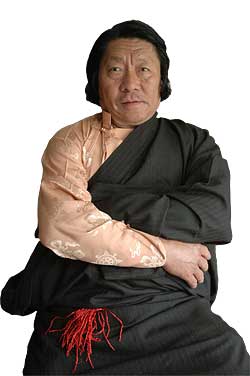
Spotlight
 The Road From Tibet The Road From Tibet
by Ann Jardine Bardsley
Dongjung was chosen by lottery—one of 1,000 selected by the Tibetan government-in-exile—to relocate to the United States. Leaving his wife and five children behind, he immigrated to Oregon.
It’s a thankless job: Every day the linens must be collected and the garbage removed—all 3.5 tons of it—from the University Health Care facility.
But Tawang Dongjung, one of 169 full-time custodians at the facility, is grateful for the opportunity.
Known for his affable and easygoing personality, Dongjung says—partly in English and partly in Tibetan, translated by his daughter, Sither Dolma—“I’m friendly with everybody.”
But Dongjung’s circuitous route from Tibet to the University of Utah and United States citizenship has been anything but easygoing.
In the early 1950s, the Chinese stormed through Tibet, and by the close of the decade, some 100,000 Tibetans had fled the country to live in exile. Leaving all her earthly possessions behind, Dongjung’s mother carried him on her back during their arduous trek to Nepal.
From there they moved to India. Dongjung lived in Dharamsala for a short time, then in Orissa, where he worked on the family’s modest farm and sold clothing and other goods in the market. He eventually met his wife, Choedon Sangmo, there. But starvation and disease were rampant in India at that time, and the couple and their growing family often went hungry.
Then, in 1993, the course of Dongjung’s life took a considerably different path when he was chosen by lottery—one of 1,000 selected by the Tibetan government-in-exile—to relocate to the United States. Leaving his wife and five children behind, he immigrated to Oregon. Soon thereafter, the Utah Tibetan Association, organized by Tibetans who have settled in the Beehive State, helped Dongjung relocate to Salt Lake City, where he had been offered a job as a cook for the House of Tibet restaurant, and later, for Café Shambala, which also specializes in Tibetan cuisine. During this time he sent his hard-earned money from these jobs to his family in India and to the Tibetan government-in-exile, based in Dharamsala.
Finally, in 1999, the Indian government granted permission for Dongjung’s wife and three younger children—Tsering Dhondup, Sither Dolma, and Tenzin Choephel—to join him in Salt Lake City. Five years later, his two oldest children, daughters Tsogyal Wangmo and Tsering Palmo, also reunited with him and the family in Utah.
Now, the whole family, including 14-month-old grandson Tenzin Yeshi, lives together in their Salt Lake City home, which is adorned with reminders of Tibet and India—colorful flags and pictures of the 14th Dalai Lama—and has a room where every member of the family prays morning and evening.
In 2001, Dongjung joined the custodial staff at LDS Hospital, and in 2004 he was hired for the same work in the University Health Care System. That year he also officially became a U.S. citizen.
Dongjung still holds down two full-time custodial jobs. “I sleep for five hours. I don’t eat,” he jokes. In fact, the entire family works hard: His two oldest daughters are employed at the U in housekeeping, and also at Primary Children’s Medical Center—both full-time jobs.
Even in the face of many hardships, Dongjung claims he wouldn’t change a thing. The road from Tibet has certainly been long and rough, but Dongjung is a “glass-is-half-full” kind of guy: He’s grateful for where he is now and pleased to work at the University.
“Everything,” he says, “is good at the U.”
–Ann Jardine Bardsley BA’84 is a writer in University Marketing & Communications.
Return to Fall 2006 Table of Contents
|



